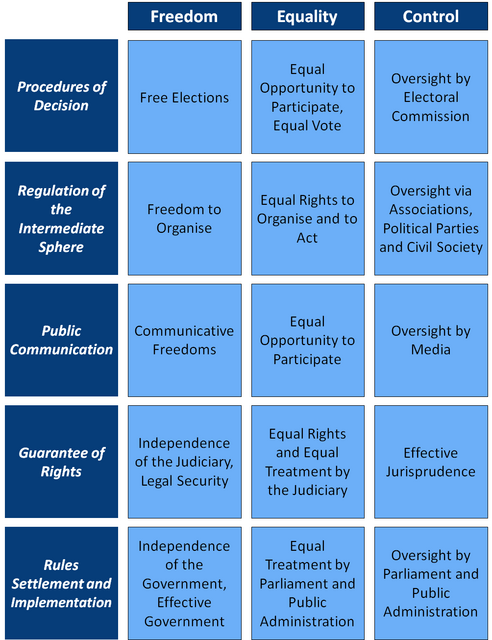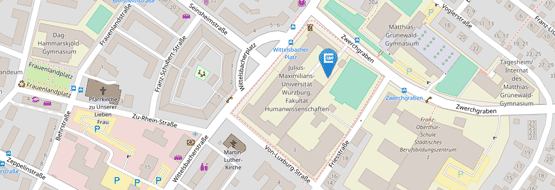DFG Research Project
DFG Research Project: “The Democracy Matrix as an Alternative to the Democracy Indices of Freedom House and Polity: Implementation of the Varieties-of-Democracy-Data by Using the 15-Field-Matrix of Democracy“ (April 2016 – April 2018)
Objectives
The measurement of democracy has developed into an important domain in Comparative Politics. Due to conceptual and methodical flaws, there are hardly any appropriate tools which offer both a long time series and a detailed analysis of single parts of democracy for the measurement of the quality of democracy. Hence, there is still a significant research gap.
This gap can be effectively closed by linking the 15-Field-Matrix to the dataset of the Varieties of Democracy. The 15-Field-Matrix by Lauth represents a conceptually well-founded approach which distinguishes between essential democratic institutions (procedures of decision, regulation of the intermediate sphere, public communication, guarantee of rights and rules settlement/implementation) and three dimensions (political freedom, political equality and political and judicial control). So far, an extensive cross-sectional or longitudinal study is still lacking due to the scarce data basis. This will change with the new, freely available dataset of the Varieties-of-Democracy-Project by the Department of Political Science at the University of Gothenburg (Sweden) and the Kellogg Institute of the University of Notre Dame (USA). This dataset, based on sophisticated methodological considerations, offers a broad range of indicators for a large number of cases over a long period of time (1900-2012).
Therefore, this project has four objectives:
- the conceptual specification of the 15-Field-Matrix as a precondition for the optimal use as a quantitative measurement tool;
- the operationalization of the matrix with the help of the Varieties-of-Democracy-data to produce the new democracy measurement tool;
- the descriptive analysis and the assessment of the validity of the new dataset for the democracy measurement;
- the creation of an English website which provides simple functions to output graphics and tables in addition to free access to the dataset, the codebook and the methodology.
Thus, the new measurement tool is based on a detailed conception of democracy. The different aggregation stages of the democracy matrix allow the researchers to determine the regime classification, and to identify potentials for improvements by the deficient characteristics of single fields, institutions or dimensions. Finally, the specifications of the dimensions and institutions can be condensed into empirical profiles of democracies which provide new insights into both the democratization process and the functioning of mature democracies. In sum, the dataset covering 200 countries over 100 years provides an excellent basis for the measurement of democracy as well as an attractive alternative to the current datasets of Polity and Freedom House.
Democracy Matrix
The democracy matrix is based on a middle range definition which enhances the minimal definition only insofar as it is necessary for a detailed analysis and which still remains within a narrow concept of democracy (Lauth 2004, 2015). By analyzing the democratic theory debate, a conception of democracy can be obtained which on the one hand consists of the dimensions of political freedom, political equality and political and judicial control and on the other hand distinguishes between five essential democratic institutions (procedures of decision, regulation of the intermediate sphere, public communication, guarantee of rights and rules settlement/implementation) (see. Tab. 1). Democracy is defined as “a constitutional kind of rule, which allows the self-determination of all citizens (in the sense of the sovereignty of the people) by guaranteeing their decisive participation in free and fair elections (of the main political representatives) and/or in political decisions (referendum). The concept includes the possibility of a continuing influence on the political process and the control of power. Democratic participation in the political process finds its expression in the dimensions of freedom, political equality, and political and judicial control.” (Lauth 2015: 8).
Table 1: The Democracy Matrix
Source: own presentation
Every single matrix field, which evolves from the combination of an institution with a dimension on the basis of the above stated conception of democracy, targets a specific pivotal feature of a democracy. The matrix of democracy differentiates between autocracies, deficient democracies and working democracies. Its strategy of analysis allows measuring the quality of institutions and dimensions separately so that an individual profile emerges for every democracy, which highlights strengths and weaknesses and which reveals trade-offs for a mature democracy as well. Furthermore, the analysis explicitly focuses on the interplay between codification and actual effectiveness of institutions.
Website and Dataset of the Democracy Matrix
The dataset and the website are available. Please visit www.democracymatrix.com.
Events and Presentations
Events
1. Workshop: „Trade-offs within the Quality of Democracy: Blind Democracy Indices or Non-Existence of Trade-offs?” [German: „Trade-offs in der Demokratiequalität: blinde Demokratiemessinstrumente oder Nichtexistenz von trade-offs?“] on 17.06.2016
Participants: PD Michael Becker, Dr. Peter Thiery, Prof. Dr. Josef Trappel
Key questions:
- Can trade-offs be justified from a democratic theory perspective?
- Which concrete trade-offs exist between dimensions and institutions?
- How can we operationalise trade-offs and measure them empirically?
2. Workshop: “Democratic Innovations and the Measurement of Democracy: Revision of the Standard Scale of the Quality of Democracy?” [German: „Demokratische Innovationen und Demokratiemessung: Revision des Maßstabs der Demokratiequalität?“] on 18.11.2016
Participants: Prof. Brigitte Geißel, Prof. Norbert Kersting, Prof. André Bächtiger
Key questions:
- Do we need to adapt the scale used to determine the quality of democracy on the basis of democratic innovations?
- Which aspects of the democracy quality are targeted by democratic innovations?
- How can we operationalise and measure the effects of democratic innovations?
Presentations
- Presentation at the workshop „Why Choice Matters – Revisiting and Comparing Measures of Democracy” on 01.06-02.06.2017 in Zurich
- Presentation at the V-Dem-Institute (Gothenburg) on 19.05.2016: “The democracy matrix as an alternative to the democracy indices of Freedom House and Polity: Implementation of the Varieties-of-Democracy-Data by using the 15-Field-Matrix of Democracy”
- Presentation at the University of Zurich on 09.06.2016: “Post-democracy and the measurement of democracy: Can we combine these research fields?” (DemocracyNet.eu-Workshop “Contextualizing Democracy: Culture, Capitalism, Inequalities”)
- Presentation at the ECPR General Conference (Prague) on 10.09.2016: „Making trade-offs visible: Theoretical und methodological considerations about the relationship between dimensions and institutions of democracy and empirical findings”
Publications
- Lauth, Hans-Joachim and Oliver Schlenkrich. 2018. Making Trade-Offs Visible: Theoretical and Methodological Considerations about the Relationship between Dimensions and Institutions of Democracy and Empirical Findings. Politics and Governance 6 (1): 78–91. Open Access
- Lauth, Hans-Joachim and Oliver Schlenkrich. 2018. Demokratie in komplexen Gesellschaften. Demokratieprofile – Responsivität – Populismus. In: Mannewitz, Tom [Hrsg.]: Die Demokratie und ihre Defekte, 145-168. Wiesbaden: VS-Verlag. Abstract [German]
- Lauth, Hans-Joachim. 2016. The internal relationships of the dimensions of democracy: The relevance of trade-offs for measuring the quality of democracy. In: International Political Science Review 37(5), S. 606–617. Abstract
- Lauth, Hans-Joachim and Oliver Schlenkrich. 2016. Making trade-offs visible: Theoretical und methodological considerations about the relationship between dimensions and institutions of democracy and empirical findings. Working Paper, vorbereitet für ECPR General Conference 7.-10. September (Prag).
- Lauth, Hans-Joachim. 2004. Demokratie und Demokratiemessung. Wiesbaden. Abstract [German]
- Lauth, Hans-Joachim. 2015. The Matrix of Democracy: A Three-Dimensional Approach to Measuring the Quality of Democracy and Regime Transformations. In: WAPS 6, S. 1-29. Link




